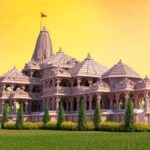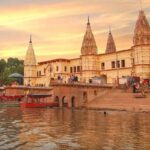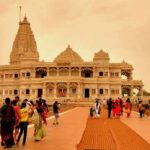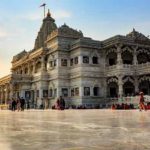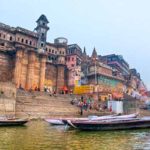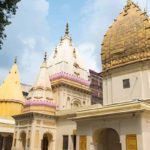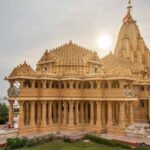Top 10 Tourist Places in Ayodhya, situated in the northern Indian state of Uttar Pradesh, holds immense cultural and religious significance, particularly for the Hindu community. It is revered as the birthplace of Lord Rama, a key figure in the Hindu epic Ramayana. The town attracts pilgrims and tourists alike due to its historical, spiritual, and architectural importance.
Tourism in Ayodhya centers around its sacred sites. The Ram Janmabhoomi, believed to be the birthplace of Lord Rama, has been a focal point of faith and controversy. The site’s significance led to the construction of the Ram Mandir, a grand temple dedicated to Lord Rama, after a prolonged legal dispute.
Besides the Ram Janmabhoomi, Ayodhya boasts several other religious landmarks. Visitors can explore the Kanak Bhavan, a revered temple dedicated to Lord Rama and his consort Sita. The Hanuman Garhi, a temple dedicated to Lord Hanuman, offers panoramic views of the city.
Ayodhya’s serene ghats along the Sarayu River are perfect for quiet contemplation or a leisurely boat ride. The town’s vibrant culture, adorned with music, dance, and local festivals, adds color to the visitor experience.
Ayodhya’s tourism not only caters to spiritual seekers but also beckons history enthusiasts and cultural explorers keen on understanding the legends, myths, and architectural marvels associated with this ancient city.
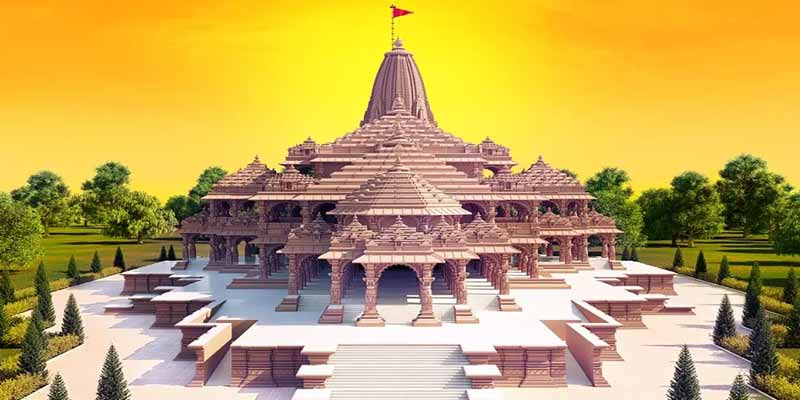
Ram Janmabhoomi Temple:
The Ram Janmabhoomi Temple is located in Ayodhya, Uttar Pradesh, India. It holds significant religious and cultural importance for Hindus as it is believed to be the birthplace of Lord Rama, a revered deity in Hinduism.
The site was at the center of a long-standing and contentious legal and socio-political dispute between Hindus and Muslims. The Babri Masjid, a mosque believed to have been built in the 16th century, stood on the same site where Hindus claim Lord Rama was born. In 1992, the Babri Masjid was demolished by a group of Hindu activists, leading to widespread riots and tensions across the country.
After decades of legal battles, the Supreme Court of India in November 2019 settled the dispute by granting the land to Hindu groups for the construction of a Ram temple. The court also directed the government to allocate a separate piece of land to the Muslim community for the construction of a mosque, Religious Places in India.
Following the court’s verdict, the construction of the Ram Janmabhoomi Temple commenced in Ayodhya. The temple’s design is based on traditional Hindu architecture and is meant to be a grand tribute to Lord Rama.
The construction of the Ram temple holds immense significance for Hindus worldwide, symbolizing the fulfillment of a long-cherished dream of having a grand temple at the birthplace of Lord Rama. The temple complex is expected to attract pilgrims and tourists once completed, serving as a cultural and religious landmark.
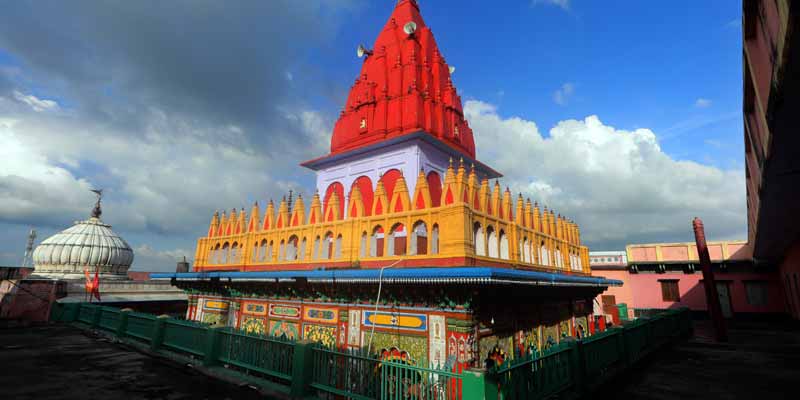
Hanuman Garhi:
Hanuman Garhi is a significant religious site located in the holy city of Ayodhya in Uttar Pradesh, India. Steeped in mythology and revered by devotees, Hanuman Garhi holds a special place in Hinduism, especially for followers of Lord Hanuman.
Situated atop a small hill, Hanuman Garhi is a temple dedicated to Lord Hanuman, the devoted disciple of Lord Rama. The temple complex is characterized by a series of steep steps that lead to the main shrine, where an idol of Lord Hanuman is enshrined in a reclining position. The temple also houses idols of Lord Rama and Goddess Sita within its premises.
One of the most striking features of Hanuman Garhi is its fortress-like appearance, with high protective walls surrounding the temple. Devotees believe that visiting this temple and seeking the blessings of Lord Hanuman brings strength, courage, and protection from evil forces, India Pilgrimage Trips.
The temple is particularly revered on Tuesdays and Saturdays, which are considered auspicious days dedicated to Lord Hanuman in Hindu tradition. Pilgrims and devotees flock to this site throughout the year, especially during festivals like Hanuman Jayanti and Ram Navami, to pay their respects and seek the blessings of the mighty deity.
Apart from its religious significance, Hanuman Garhi offers panoramic views of the city of Ayodhya, providing visitors with a serene and picturesque setting for contemplation and worship. The temple’s tranquil ambiance and spiritual aura make it a must-visit destination for spiritual seekers and devotees visiting Ayodhya, immersing them in the divine presence of Lord Hanuman and the rich tapestry of Hindu mythology.
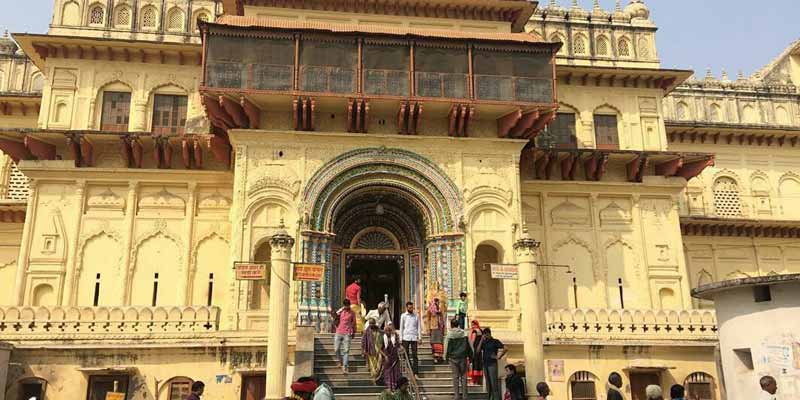
Kanak Bhawan:
Kanak Bhawan, situated in Ayodhya, Uttar Pradesh, holds immense cultural and historical significance in Hindu mythology and architectural heritage. Also known as Sone ka Ghar (House of Gold), this revered temple is dedicated to Lord Rama and his consort, Sita. The name “Kanak Bhawan” translates to “Golden House,” a fitting epithet considering the fascinating legend associated with its construction.
According to Hindu mythology, King Dasharatha, Lord Rama’s father, gifted this magnificent palace to his daughter-in-law Sita as a wedding present. The unique aspect of this temple lies in its extraordinary history. Legend has it that Sita, upon entering the palace, was displeased with its original appearance. In response to her discomfort, Lord Rama summoned the divine architect, Vishwakarma, to transform the palace into an opulent and radiant abode. Vishwakarma’s craftsmanship turned the ordinary structure into a resplendent edifice made of gold, showcasing intricate artwork and designs.
Kanak Bhawan’s architecture blends Rajasthani and Gujarati styles, showcasing stunning murals and paintings that depict various episodes from the Ramayana. The temple’s interior is adorned with beautiful images of Lord Rama and Sita, providing devotees with a serene and spiritually uplifting atmosphere.
Pilgrims and tourists flock to Kanak Bhawan to witness its architectural splendor and pay homage to Lord Rama and Sita. The temple’s serene ambiance, coupled with its historical significance and divine associations, makes it a must-visit destination for those exploring the religious and cultural heritage of Ayodhya. Kanak Bhawan stands as a testament to the enduring legacy of the epic Ramayana and continues to attract visitors seeking spiritual solace and marveling at its architectural grandeur.
Treta Ke Thakur:
“Treta Ke Thakur Ayodhya” refers to the revered deity Rama, also known as the “Thakur,” and Ayodhya, the ancient city where Lord Rama is believed to have been born and ruled. The phrase encapsulates the significance of Ayodhya as the birthplace and kingdom of Lord Rama during the Treta Yuga, a historic period in Hindu mythology.
Ayodhya holds immense spiritual and cultural importance for Hindus worldwide, especially devotees of Lord Rama. The city is mentioned in various ancient scriptures and epics like the Ramayana, which narrates the life and adventures of Lord Rama, depicting his virtuous reign, marriage to Sita, and victory over the demon king Ravana.
The phrase “Treta Ke Thakur Ayodhya” embodies the essence of a bygone era when Lord Rama, an incarnation of Lord Vishnu, graced the Earth with his divine presence. It reflects the belief that Ayodhya was the capital of Lord Rama’s illustrious kingdom and the epicenter of his righteous rule, characterized by justice, compassion, and dharma (righteousness).
For devout Hindus, Ayodhya is not just a historical city but a sacred pilgrimage site where the devotion to Lord Rama runs deep. The city continues to be a focal point of religious fervor and cultural significance, especially surrounding the temple dedicated to Lord Rama—the Ram Janmabhoomi temple.
The phrase “Treta Ke Thakur Ayodhya” thus symbolizes the spiritual heritage, religious reverence, and the eternal connection of Ayodhya to the revered deity Lord Rama, evoking sentiments of devotion and reverence among followers of Hinduism.
Nageshwarnath Temple:
The Nageshwarnath Temple is a significant religious site located in Ayodhya, Uttar Pradesh, India. It holds immense religious and historical importance, deeply ingrained in the cultural fabric of the region.
Dedicated to Lord Shiva, the Nageshwarnath Temple stands as a revered pilgrimage destination for devotees, particularly Shaivites, followers of Lord Shiva. It is believed to have been established by Kush, the son of Lord Rama, making it an ancient and revered shrine associated with the epic Ramayana.
The temple’s architecture is a blend of historical styles that have evolved over centuries. The complex features intricate carvings and sculptures, showcasing the craftsmanship of the artisans from different periods. The main sanctum enshrines a Shiva Linga, the symbol of Lord Shiva, which remains the focal point of worship and devotion for countless devotees.
Legend has it that Lord Rama himself installed the Shivling at this sacred site during his time in Ayodhya. Consequently, the temple has been a site of continuous veneration and has withstood the tests of time, making it a significant cultural and religious heritage site.
Throughout the year, especially during festivals like Maha Shivaratri and Shravan Month, the temple sees an influx of devotees who gather to seek blessings, offer prayers, and participate in various rituals and ceremonies conducted in reverence to Lord Shiva.
The Nageshwarnath Temple stands not only as a religious edifice but also as a symbol of the cultural and spiritual heritage of Ayodhya, inviting devotees and tourists alike to experience its divine ambiance and historical significance.
Swarg Dwar:
Swarg Dwar, or the Gateway to Heaven, holds significant religious and cultural importance in Ayodhya, a revered city in Hinduism located in the state of Uttar Pradesh, India. It is a site deeply embedded in the spiritual fabric of the region, resonating with the mythology and beliefs associated with Lord Ram, a central figure in Hinduism.
According to Hindu legend, Swarg Dwar is believed to be the place where Lord Ram commenced his final journey to heaven, also known as his ‘Punya Dham.’ It is said that after completing his earthly duties and ruling Ayodhya, Lord Ram along with his brothers—Lakshman, Bharat, and Shatrughna—left for his divine abode from this very spot.
Swarg Dwar stands as a symbolic representation of this departure, revered by millions of devotees who visit Ayodhya annually to pay homage to Lord Ram and immerse themselves in the spiritual ambiance. The site is marked by a significant archway or gate, often adorned with colorful decorations and religious motifs, serving as a reminder of the divine departure that took place here.
Pilgrims flock to Swarg Dwar to seek blessings, perform religious rituals, and witness the place where Lord Ram embarked on his celestial journey. The atmosphere is filled with a sense of reverence, spirituality, and devotion, making it a focal point for religious ceremonies and cultural festivities, particularly during auspicious occasions and festivals associated with Lord Ram.
Swarg Dwar, with its historical and religious significance, stands as a testament to the enduring faith and devotion of millions toward Lord Ram and serves as a place of profound spiritual significance in the hearts of devotees who continue to be drawn to this sacred site in Ayodhya.
Guptar Ghat:
Guptar Ghat in Ayodhya is a sacred site along the banks of the Sarayu River, steeped in deep historical and religious significance within Hindu mythology. The name ‘Guptar’ translates to ‘hidden,’ and this ghat holds a revered place due to its association with Lord Rama, a principal figure in the Hindu epic Ramayana.
Legend has it that Guptar Ghat was the location where Lord Rama took jal samadhi, a symbolic immersion into the Sarayu River, marking the end of his earthly existence. According to the epic, after completing his divine incarnation and fulfilling his duties as the ideal king, Lord Rama chose to depart from the mortal realm.
Devotees believe that Lord Rama, an embodiment of righteousness and virtue, chose this serene ghat for his departure to his divine abode (Vaikuntha). His self-immersion in the sacred waters of the Sarayu at Guptar Ghat symbolizes his return to his celestial origins and serves as a significant spiritual event for followers of Lord Rama.
Guptar Ghat attracts pilgrims and devotees from across the country, especially during religious festivals and auspicious occasions. Visitors partake in ritualistic baths and offer prayers, seeking blessings and spiritual solace while immersing themselves in the pious ambiance of this revered site.
The ghat holds immense cultural and religious importance, fostering a tranquil atmosphere where devotees reflect upon Lord Rama’s teachings and legacy. It stands as a testament to the enduring reverence and devotion that millions hold for Lord Rama, making it an integral part of Ayodhya’s spiritual tapestry.
Kala Ram Mandir:
The Kala Ram Mandir, situated in Ayodhya, Uttar Pradesh, is an iconic temple revered for its historical and religious significance. This sacred site holds a special place in Hindu mythology and is dedicated to Lord Rama, an incarnation of the revered deity Vishnu.
The Kala Ram Mandir, translated as the “Black Rama Temple,” stands out due to the unique black stone idol of Lord Rama housed within its sanctum sanctorum. This temple, adorned with intricate architectural elements, draws devotees and tourists alike, offering a serene ambiance for spiritual reflection and worship.
The history of this temple intertwines with the rich tapestry of Ayodhya’s cultural heritage. It’s believed that the temple’s origins date back centuries, possibly built during the reign of the Mughal emperor Babur. Over time, it underwent various renovations and enhancements, preserving its spiritual essence while reflecting diverse architectural influences.
Devotees flock to the Kala Ram Mandir throughout the year, especially during auspicious occasions like Ram Navami, the celebration of Lord Rama’s birth. The temple’s atmosphere during these festivities is vibrant and resonates with devotional fervor, echoing hymns and prayers dedicated to Lord Rama.
Apart from its religious significance, the temple’s serene surroundings and architectural marvels captivate visitors. The intricate carvings and detailed craftsmanship on the temple walls and pillars stand as a testament to the skilled artisans of ancient times.
The Kala Ram Mandir stands not just as a religious edifice but as a symbol of faith, cultural heritage, and architectural brilliance, beckoning pilgrims and enthusiasts to experience the divine aura and historical legacy it embodies.
Lakshmana Ghat:
Lakshmana Ghat in Ayodhya holds immense cultural and religious significance in Hindu mythology. Situated on the banks of the sacred Sarayu River, this revered ghat is named after Lakshmana, the younger brother of Lord Rama.
According to Hindu epics like the Ramayana, it is believed that during the period of the exile of Lord Rama, Lakshmana, deeply devoted to his brother, established this ghat for Rama’s ritualistic prayers and sacred routines. Lakshmana Ghat stands as a testament to the bond between the two brothers and their devotion to dharma (righteousness).
Pilgrims and devotees visit Lakshmana Ghat to perform religious rituals, take holy dips in the Sarayu River, and seek blessings. The ghat is a serene and spiritually charged spot where devotees come to offer prayers, especially during religious festivals and auspicious occasions.
The tranquil ambiance, coupled with the panoramic views of the river, attracts tourists seeking solace and spiritual rejuvenation. Devotees believe that taking a dip in the Sarayu River at Lakshmana Ghat cleanses them of sins and bestows spiritual merit.
The ghat also serves as a venue for various religious ceremonies and cultural events, adding vibrancy to the spiritual tapestry of Ayodhya.
With its historical significance deeply rooted in Hindu mythology and its serene riverside setting, Lakshmana Ghat remains a revered destination, drawing pilgrims, tourists, and devotees seeking spiritual solace and a connection to ancient Indian heritage and beliefs.
Gulab Bari:
Gulab Bari, located in Ayodhya, Uttar Pradesh, is a serene and historically significant garden that stands as a testament to the rich cultural heritage of the region. Literally translating to ‘Garden of Roses,’ Gulab Bari is a picturesque enclosure adorned with vibrant flowers, lush greenery, and architectural remnants that echo tales of its glorious past.
Built during the reign of Nawab Shuja-ud-Daula, the Nawab of Awadh, in the 18th century, Gulab Bari was designed to captivate the senses with its exquisite beauty and soothing ambiance. The garden spans across acres, featuring well-manicured lawns, pathways lined with fragrant rose bushes, and water channels adding a touch of tranquility.
The centerpiece of Gulab Bari is the mausoleum of Nawab Shuja-ud-Daula and his family members. The mausoleum, a striking architectural marvel, showcases intricate Mughal and Awadhi designs, including ornate domes, intricate carvings, and delicate motifs that reflect the craftsmanship of that era.
Visitors are enchanted by the symmetrical layout, peaceful aura, and the delightful fragrance of the myriad of roses that bloom in vibrant hues. The garden’s layout encourages leisurely strolls, providing moments of reprieve and reflection amid its historical significance.
Gulab Bari stands not only as a beautiful garden but also as a reminder of the Nawabi era’s architectural brilliance and the cultural heritage of Ayodhya. It offers a tranquil escape for locals and tourists alike, inviting them to immerse themselves in its timeless beauty while appreciating the historical legacy it represents.
Varanasi Tour Planner


